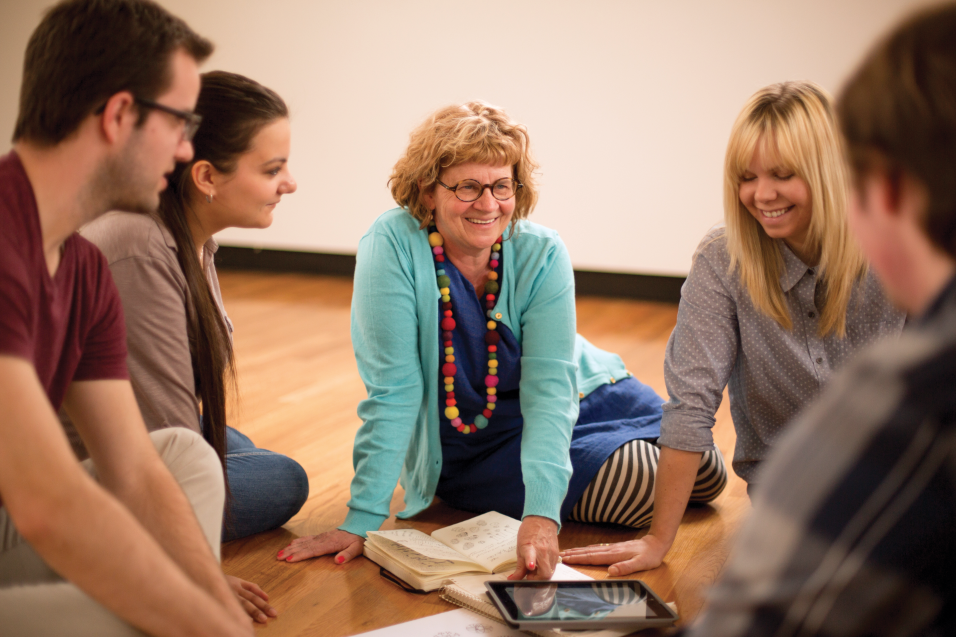Researcher Leanne Elias (BFA '95, MEd '03) may have the answer. A designer, artist and associate professor of new media at the University of Lethbridge, Elias has developed a unique model for creating productive working relationships, particularly among those with disparate views. It’s all part of her passion for building strong communities, and ultimately, helping to drive social change.
“I’m really interested in connecting people,” says Elias, the latest recipient of the University of Lethbridge Students’ Union’s Teaching Excellence Award. The honour recognizes outstanding efforts to increase students’ learning experiences. “Collaborative work doesn’t happen through cold calling. It happens when you provide opportunities for people to meet in person. Before anything else can happen, you have to build trust.”
From there, she says, great ideas can take shape and exciting initiatives can take off. But Elias does more than just talk about trust; she demonstrates the importance of it in her multidisciplinary projects.

One example is Ecotone, a three-year initiative that focused on environmental stress in southern Alberta. Well aware that environmentalism and climate change can be divisive topics in this oil-rich and agriculturally prolific province, Elias wanted to help build a collective of concerned citizens who were interested in sustainability, and protecting Alberta’s land and water resources. To build such a community, she and a local entomologist organized 140 people who, at first blush,
had little in common – artists, scientists
and ranchers.
During the grassroots project, which was funded by the Alberta Rural Development Network, each group explained their work to the others. To start, the scientists presented their research on land use and the health of the Prairies. Next, 15 professional contemporary artists spent time on ranches across southern Alberta, learning about the realities of agricultural life. Finally, the artists translated their ranching experiences into creative works that were exhibited at the Southern Alberta Art Gallery in downtown Lethbridge.
All three groups reported new insights from their participation in Ecotone. The scientists, for instance, realized that artists conduct research, and in turn, the artists learned more about scientific investigations and food production. Meanwhile, the ranchers developed an appreciation for artistic endeavours.
Ultimately, Ecotone’s model of collaboration eliminated communication barriers among people who had never before interacted. Equally important, the participants continue to meet and discuss environmental issues to this day. It’s an outcome that pleases Elias and will no doubt be mentioned during a presentation that she and her graduate student Christine Clark (BFA í10) will deliver during a conference in Sweden this June. The Design Research Society Conference will enable Elias and Clark, a master of fine arts student in new media, to share the paper they co-authored on the success of Ecotone.
Committed to the creative and professional growth of the next generation of researchers, artists and designers, Elias often collaborates with students on her research projects. “It’s exciting to see ideas being sparked in students,” she says. “I learn as much from them as they learn from me.”

To that end, Elias regularly takes students to South by Southwest (SXSW), an annual music, film and interactive conference and festival held in Austin, Texas. A dazzling showcase of digital creativity with presentations from the brightest minds in emerging technology, the SXSW interactive festival, in particular, is a wonderland for new media students.
“You attend talks given by your heroes and network with like-minded people and innovators,” says Clark. “Through my work with Leanne, I’ve really been opened up to the idea of being more involved in communities of practice.”
In fact, Clark was part of a group of graduate students who, at the request of Elias, interviewed artists, educators and practitioners of new media at SXSW and in New York City about how they adapt to changes in the medium. The videos were then edited by undergraduate students and posted on a website that Clark designed. An evolving video catalogue that explores the collaboration and overlap between new media and other
disciplines, Newmediaintersections.com, is funded by the U of L’s Interdisciplinary Research Development Fund. Elias serves as the project’s principle investigator and is aided by U of L professors Dr. Janice Rahn (Education), Denton Fredrickson (Art), Dr. Dana Cooley (New Media) and Dr. John Usher (Management).
“The site shows how new media is impacting other disciplines and can work together with, for example, management and the sciences,” says Elias. “There are so many possibilities.”
This story appears in the Spring 2014 edition of SAM magazine. For a look at the full issue in a flipbook format, follow this link.
